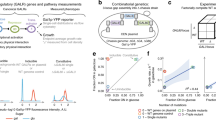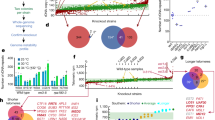Abstract
Natural genetic variation can cause significant differences in gene expression, but little is known about the polymorphisms that affect gene regulation. We analyzed regulatory variation in a cross between laboratory and wild strains of Saccharomyces cerevisiae. Clustering and linkage analysis defined groups of coregulated genes and the loci involved in their regulation. Most expression differences mapped to trans-acting loci. Positional cloning and functional assays showed that polymorphisms in GPA1 and AMN1 affect expression of genes involved in pheromone response and daughter cell separation, respectively. We also asked whether particular classes of genes were more likely to contain trans-regulatory polymorphisms. Notably, transcription factors showed no enrichment, and trans-regulatory variation seems to be broadly dispersed across classes of genes with different molecular functions.
This is a preview of subscription content, access via your institution
Access options
Subscribe to this journal
Receive 12 print issues and online access
$209.00 per year
only $17.42 per issue
Buy this article
- Purchase on Springer Link
- Instant access to full article PDF
Prices may be subject to local taxes which are calculated during checkout



Similar content being viewed by others
References
Oleksiak, M.F., Churchill, G.A. & Crawford, D.L. Variation in gene expression within and among natural populations. Nat. Genet. 32, 261–266 (2002).
Brem, R.B., Yvert, G., Clinton, R. & Kruglyak, L. Genetic dissection of transcriptional regulation in budding yeast. Science 296, 752–755 (2002).
Cowles, C.R., Hirschhorn, J.N., Altshuler, D. & Lander, E.S. Detection of regulatory variation in mouse genes. Nat. Genet. 32, 432–437 (2002).
Yan, H., Yuan, W., Velculescu, V.E., Vogelstein, B. & Kinzler, K.W. Allelic variation in human gene expression. Science 297, 1143 (2002).
Rockman, M.V. & Wray, G.A. Abundant raw material for cis-regulatory evolution in humans. Mol. Biol. Evol. 19, 1991–2004 (2002).
Cheung, V.G. et al. Natural variation in human gene expression assessed in lymphoblastoid cells. Nat. Genet. 33, 422–425 (2003).
Schadt, E.E. et al. Genetics of gene expression surveyed in maize, mouse and man. Nature 422, 297–302 (2003).
Knight, J.C., Keating, B.J., Rockett, K.A. & Kwiatkowski, D.P. In vivo characterization of regulatory polymorphisms by allele-specific quantification of RNA polymerase loading. Nat. Genet. 33, 469–475 (2003).
Wu, L.F. et al. Large-scale prediction of Saccharomyces cerevisiae gene function using overlapping transcriptional clusters. Nat. Genet. 31, 255–265 (2002).
Eisen, M.B., Spellman, P.T., Brown, P.O. & Botstein, D. Cluster analysis and display of genome-wide expression patterns. Proc. Natl. Acad. Sci. USA 95, 14863–14868 (1998).
Gasch, A.P. et al. Genomic expression programs in the response of yeast cells to environmental changes. Mol. Biol. Cell 11, 4241–4257 (2000).
Hughes, T.R. et al. Functional discovery via a compendium of expression profiles. Cell 102, 109–126 (2000).
Spellman, P.T. et al. Comprehensive identification of cell cycle-regulated genes of the yeast Saccharomyces cerevisiae by microarray hybridization. Mol. Biol. Cell 9, 3273–3297 (1998).
Chu, S. et al. The transcriptional program of sporulation in budding yeast. Science 282, 699–705 (1998).
Jansen, R.C. & Nap, J.P. Genetical genomics: the added value from segregation. Trends Genet. 17, 388–391 (2001).
Jansen, R.C. Opinion: studying complex biological systems using multifactorial perturbation. Nat. Rev. Genet. 4, 145–151 (2003).
Winzeler, E.A. et al. Direct allelic variation scanning of the yeast genome. Science 281, 1194–1197 (1998).
Hirsch, J.P., Dietzel, C. & Kurjan, J. The carboxyl terminus of Scg1, the G alpha subunit involved in yeast mating, is implicated in interactions with the pheromone receptors. Genes Dev. 5, 467–474 (1991).
Brown, A.J. et al. Functional coupling of mammalian receptors to the yeast mating pathway using novel yeast/mammalian G protein α-subunit chimeras. Yeast 16, 11–22 (2000).
Kellis, M., Patterson, N., Endrizzi, M., Birren, B. & Lander, E.S. Sequencing and comparison of yeast species to identify genes and regulatory elements. Nature 423, 241–254 (2003).
Souciet, J. et al. Genomic exploration of the hemiascomycetous yeasts: 1. A set of yeast species for molecular evolution studies. FEBS Lett. 487, 3–12 (2000).
Colman-Lerner, A., Chin, T.E. & Brent, R. Yeast Cbk1 and Mob2 activate daughter-specific genetic programs to induce asymmetric cell fates. Cell 107, 739–750 (2001).
Wang, Y., Shirogane, T., Liu, D., Harper, J.W. & Elledge, S.J. Exit from exit: resetting the cell cycle through Amn1 inhibition of G protein signaling. Cell 112, 697–709 (2003).
Giaever, G. et al. Functional profiling of the Saccharomyces cerevisiae genome. Nature 418, 387–391 (2002).
Lee, T.I. et al. Transcriptional regulatory networks in Saccharomyces cerevisiae. Science 298, 799–804 (2002).
Simon, I. et al. Serial regulation of transcriptional regulators in the yeast cell cycle. Cell 106, 697–708 (2001).
Jones, E.W., Pringle, J.R. & Broach, J.R. The molecular and cellular biology of the yeast Saccharomyces (Cold Spring Harbor Laboratory Press, Cold Spring Harbor, New York, 1992).
Forsburg, S.L. & Guarente, L. Identification and characterization of HAP4: a third component of the CCAAT-bound HAP2/HAP3 heteromer. Genes Dev. 3, 1166–1178 (1989).
Spector, M.S., Raff, A., DeSilva, H., Lee, K. & Osley, M.A. Hir1p and Hir2p function as transcriptional corepressors to regulate histone gene transcription in the Saccharomyces cerevisiae cell cycle. Mol. Cell. Biol. 17, 545–552 (1997).
Guelzim, N., Bottani, S., Bourgine, P. & Kepes, F. Topological and causal structure of the yeast transcriptional regulatory network. Nat. Genet. 31, 60–63 (2002).
Ashburner, M. et al. Gene ontology: tool for the unification of biology. The Gene Ontology Consortium. Nat. Genet. 25, 25–29 (2000).
Olson, M.V. When less is more: gene loss as an engine of evolutionary change. Am. J. Hum. Genet. 64, 18–23 (1999).
Rifkin, S.A., Kim, J. & White, K.P. Evolution of gene expression in the Drosophila melanogaster subgroup. Nat. Genet. 33, 138–144 (2003).
Brachmann, C.B. et al. Designer deletion strains derived from Saccharomyces cerevisiae S288C: a useful set of strains and plasmids for PCR-mediated gene disruption and other applications. Yeast 14, 115–132 (1998).
Mortimer, R.K., Romano, P., Suzzi, G. & Polsinelli, M. Genome renewal: a new phenomenon revealed from a genetic study of 43 strains of Saccharomyces cerevisiae derived from natural fermentation of grape musts. Yeast 10, 1543–1552 (1994).
Goldstein, A.L. & McCusker, J.H. Three new dominant drug resistance cassettes for gene disruption in Saccharomyces cerevisiae. Yeast 15, 1541–1553 (1999).
Gietz, R.D. & Woods, R.A. Transformation of yeast by lithium acetate/single-stranded carrier DNA/polyethylene glycol method. Methods Enzymol. 350, 87–96 (2002).
Baudin, A., Ozier-Kalogeropoulos, O., Denouel, A., Lacroute, F. & Cullin, C. A simple and efficient method for direct gene deletion in Saccharomyces cerevisiae. Nucleic Acids Res. 21, 3329–3330 (1993).
Lorenz, M.C. et al. Gene disruption with PCR products in Saccharomyces cerevisiae. Gene 158, 113–117 (1995).
Foss, E.J. Tof1p regulates DNA damage responses during S phase in Saccharomyces cerevisiae. Genetics 157, 567–577 (2001).
Acknowledgements
We thank J. Delrow, D. Hare, J. Marty and the Fred Hutchinson Cancer Research Center microarray, oligo synthesis and sequencing facilities for technical assistance; M. Eberle and H. Childs for help in manuscript preparation; D. Gottschling and R. Young for discussions; and H. Coller for discussions and a critical reading of the manuscript. G.Y. and R.B. were supported by postdoctoral fellowships from the Human Frontier Science Program and the National Institutes of Health, respectively. This work was supported by the Howard Hughes Medical Institute, of which L.K. is an associate investigator. L.K. is a James S. McDonnell Centennial Fellow.
Author information
Authors and Affiliations
Corresponding author
Ethics declarations
Competing interests
The authors declare no competing financial interests.
Supplementary information
Rights and permissions
About this article
Cite this article
Yvert, G., Brem, R., Whittle, J. et al. Trans-acting regulatory variation in Saccharomyces cerevisiae and the role of transcription factors. Nat Genet 35, 57–64 (2003). https://doi.org/10.1038/ng1222
Received:
Accepted:
Published:
Issue Date:
DOI: https://doi.org/10.1038/ng1222
This article is cited by
-
Yeast of Eden: microbial resistance to glyphosate from a yeast perspective
Current Genetics (2023)
-
Drug-dependent growth curve reshaping reveals mechanisms of antifungal resistance in Saccharomyces cerevisiae
Communications Biology (2022)
-
Molecular and evolutionary processes generating variation in gene expression
Nature Reviews Genetics (2021)
-
Fully automated web-based tool for identifying regulatory hotspots
BMC Genomics (2020)
-
Weighting sequence variants based on their annotation increases the power of genome-wide association studies in dairy cattle
Genetics Selection Evolution (2019)



